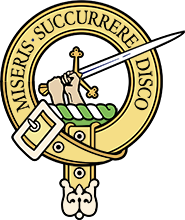MacMillans in Knapdale
Though tradition suggests the ancestors of the 18th century clan chiefs did not arrive in Knapdale until the 15th century, it's probable that MacMillans had been established there long before that - maybe indeed ever since the birth of the clan. The first of Maolan's descendants to be documented in the area is John de Lany who was Constable of Tarbert Castle in 1326. Alexander MacMillan is said to have built the square tower at Castle Sween (see photo in the carousel above) when he was Constable there in the 1470s, and it's his name that appears on the first of the two late 15th century crosses at Kilmory Knap.
The second cross, which is now missing it's top and any legible inscription - though fortunately what it said was recorded by a visiting antiquary in the 17th century - bore the names of Alexander's son Malcolm and grandson Duncan. When the Campbells were installed by the crown as the lords of Knapdale in the early 16th century the MacMillans there entered a period of obscurity, from which they re-emerged in 1666 as the lairds of Dunmore which may well have been the clan's principal seat in Knapadale for centuries past. The present house at Dunmore was built however some time after the last MacMillans lived there.
MacMillan's title-deed to Knap
Rubha Mhic Ghille-mhaoil, Gaelic for "MacMillan's Rock", was a boulder, visible at low tide, with a sonnet inscribed on it. There are two versions of what this inscription was to have said. One is to have stated in Gaelic:
Coir MhicMhaolain air a Chnap,
Fhads a bhuaileas tonn ri crag.
This translates to:
MacMillan's right to Knap shall be,
As long's this rock withstands the sea.
Like the sonnet, the location has been disputed. Point of Knap immediately south of Castle Sween and Kilmory Knap was posited by one tradition. Another suggests it was situated at Kilberry Point (see a photo in the carousel above) near the ancient MacMillan seat at Dunmore. This was more likely as North Knapdale with the Point of Knap were held by Clan MacMillan for only about a decade. This rock has since disappeared, said to have been rolled deeper into the sea by Campbells, whose clan was to take ownership of Knapdale in the late 15th century.
1841 census
A more quantifiable measure of the presence of M'Millans in Knapdale is the census of 1841. Though almost a century after the clans ceased functioning in their traditional sense, M'Millan was the most numerous name in South Knapdale at 104 (not including sept names like Blue of which there were 10), ahead of Campbells at 93. In North Knapdale M'Millans are 26, Blues 32 and Campbells 272. Read more in the Clan MacMillan International Magazine, December 2016 issue.
See a map of MacMillan sites in Knapdale as a PDF.
Articles relating to Knapdale in Clan MacMillan International magazines and newsletters:
Knapdale Sites - Nov./Dec. 2003, Issue 1
Traditions of Knapdale MacMillans - May/June 2004, Issue 2
The MacMillans of Dunmore - May/June 2004, Issue 2
A Cross for Cormac at Kilberry? - Dec. 2014, Issue 19
See the Project MAOL Indexes page for the descent of MacMillans of Dunmore and other MacMillan families in Knapdale.













